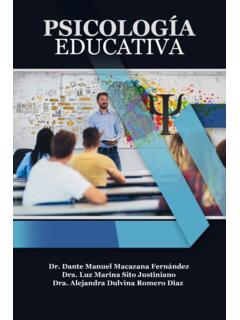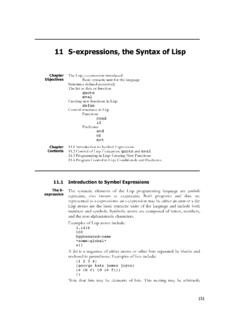Transcription of Solving Diophantine Equations - University of New Mexico
1 Solving Diophantine EquationsOctavian Cira and Florentin Smarandache20142 PrefaceIn recent times the we witnessed an explosion of Number Theory prob-lems that are solved using mathematical software and powerful comput-ers. The observation that the number of transistors packed on integratedcircuits doubles every two years made by Gordon E. Moore in 1965 is stillaccurate to this day. With ever increasing computing power more andmore mathematical problems can be tacked using brute force. At the sametime the advances in mathematical software made tools like Maple, Math-ematica, Matlab or Mathcad widely available and easy to use for the vastmajority of the mathematical research community. This tools don t onlyperform complex computations at incredible speeds but also serve as agreat tools for symbolic computation, as proving tools or algorithm online meeting of the two authors lead to lively exchange of ideas,solutions and observation on various Number Theory problems.
2 The everincreasing number of results, Solving techniques, approaches, and algo-rithms led to the the idea presenting the most important of them in inthis volume. The book offers solutions to a multitude of Diophantineequation proposed by Florentin Smarandache in previous works [Smaran-dache, 1993, 1999b, 2006] over the past two decades. The expertise in tack-ling Number Theory problems with the aid of mathematical software suchas [Cira and Cira, 2010], [Cira, 2013, 2014a, Cira and Smarandache, 2014,Cira, 2014b,c,d,e] played an important role in producing the algorithmsand programs used to solve over62 Diophantine equation. There arenumerous other important publications related to Diophantine Equationsiiithat offer various approaches and solutions.
3 However, this book is differ-ent from other books of number theory since it dedicates most of its spaceto Solving Diophantine Equations involving the Smarandache function. Asearch for similar results in online resources likeThe On-Line Encyclopediaof Integer Sequencesreveals the lack of a concentrated effort in this brute force approach for Solving Diophantine equation is a wellknown technique that checks all the possible solutions against the problemconstrains to select the correct results. Historically, the proof of conceptwas done by Appel and Haken [1977] when they published the proof forthefour color maptheorem. This is considered to be the the first theoremthat was proven using a computer. The approach used both the computingpower of machines as well as theoretical results that narrowed down infi-nite search space to1936map configurations that had to be check.
4 Despitesome controversy in the 80 when a masters student discovered a seriesof errors in the discharging procedure, the initial results was correct. Ap-pel and Haken went on to publish a book [Appel and Haken, 1989] thatcontained the entire and correct prof thatevery planar map is , in 2014 an empirical results of Goldbach conjecture was pub-lished in Mathematics of Computation where Oliveira e Silva et al. [2013],[Oliveira e Silva, 2014], confirm the theorem to be true for all even num-bers not larger than4 use of Smarandache function that involves the set of all primenumbers constitutes one of the main reasons why, most of the problemsproposed in this book do not have a finite number of cases. It could bepossible that the unsolved problems from this book could be classified inclasses of unsolved problems, and thus Solving a single problem will helpin Solving all the unsolved problems in its class.
5 But the authors could notclassify them in such classes. The interested readers might be able to dothat. In the given circumstances the authors focused on providing the mostcomprehensive partial solution possible, similar to other such solutions inthe literature like: Goldbach s conjecture. In 2003 Oliveira e Silva announced that alleven numbers 2 1016can be expressed as a sum of two 2014 the partial result was extended to all even numbers smallerthen4 1018, [Oliveira e Silva, 2014]. For any positive integern, letf(n)denote the number of solutionsto the Diophantine equation4/n= 1/x+ 1/y+ 1/zwithx,y,zposi-tive integers. TheErd os-Straus conjecture, [Obl ath, 1950, Rosati, 1954,Bernstein, 1962, Tao, 2011], asserts thatf(n) 1for everyn [2006] established that the conjecture is true for all integers foranyn 1014.
6 Elsholtz and Tao [2012] established some related re-sults onfand related quantities, for instance established the boundf(p) p3/5+O(1/log(log(p)))for all primesp. Tutescu [1996] stated that (n)6= (n+ 1)for anyn N . On March3rd, 2003 Weisstein published a paper stating that all the relation isvalid for all numbers up to109, [Sondow and Weisstein, 2014]. A numbernisk hyperperfect for some integerskifn= 1 +k s(n),wheres(n)is the sum of the proper divisors ofn. Allk hyperperfectnumbers less than1011have been computed. It seems that the con-jecture allk hyperperfect numbers for oddk >1are of the formp2 q,withp= (3k+ 4)/4prime andq= 3k+ 4 = 2p+ 3prime is false[McCranie, 2000].This results do not offer the solutions to the problems but they are impor-tant contributions worth emergence of mathematical software generated a new wave ofmathematical research aided by computers.
7 Nowadays it is almost impos-sible to conduct research in mathematics without using software solutionssuch as Maple, Mathematica, Matlab or Mathcad, etc. The authors usedextensively Mathcad to explore and solve various Diophantine equationsbecause of the very friendly nature of the interface and the powerful pro-gramming tools that this software provides. All the programs presentedin the following chapters are in their complete syntax as used in compact nature of the code and ease of interpretation made the choiceof this particular software even more appropriate for use in a written pre-sentation of Solving empirical search programs in this book where developed and exe-cuted in Mathcad. The source code of this algorithms can be interpreted aspseudo code (the Mathcad syntax allows users to write code that is veryeasy to read) and thus translated to other programming the intention of the authors was to provide the reader witha comprehensive book some of the notions are presented out of order.
8 Forexample the book the primality test that used Smarandache s function isextensively used. The first occurrences of this test preceded the definitionthe actual functions and its properties. However, overall, the text coversall definition and proves for each mathematical construct used. At thesame time the references point to the most recent publications in literature,while results are presented in full only when the number of solutions isreasonable. For all other problems, that generate in excess of100double,triple or quadruple pairs, only partial results are contained in the sectionsof this book. Nevertheless, anyone interested in the complete list shouldcontact the authors to obtain a electronic copy of it.
9 Running the programsin this book will also generate the same complete list of possible solutionsfor any odd the problems in this would like to thank all the collaborators that helped putting to-gether this book, especially to Codrut a Stoica and Cristian Mihai Cira, forthe important comments and of figurexList of tablexiIntroductionxii1 Prime prime numbers .. tests .. test of primality .. tests .. s criteria of primality .. product of prime factors .. factorization .. methods of factorization .. of the prime numbers .. of counting of the prime numbers .. of counting of the prime numbers ..40vviCONTENTS2 Smarandache s function properties of function.
10 For Kempner s algorithm .. the of values function ..543 Divisor functions divisor function .. the values of kfunctions .. hyperperfect numbers ..634 Euler s totient function properties of function .. the values of function .. generalization of Euler s theorem .. algorithm to solve congruences ..735 Generalization of congruence introductory .. of congruence of the Number Theory .. unifying point of convergence theorems ..846 Analytical Diophantine Equations .. linear Diophantine equation .. number of solutions of equation .. equation of first order with two unknown the Diophantine linear systems .. of Solving with row reduced echelon form with Smith normal form.





